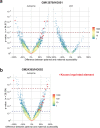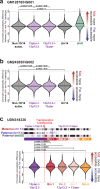This is a preprint.
Synchronized long-read genome, methylome, epigenome, and transcriptome for resolving a Mendelian condition
- PMID: 37808736
- PMCID: PMC10557686
- DOI: 10.1101/2023.09.26.559521
Synchronized long-read genome, methylome, epigenome, and transcriptome for resolving a Mendelian condition
Update in
-
Synchronized long-read genome, methylome, epigenome and transcriptome profiling resolve a Mendelian condition.Nat Genet. 2025 Feb;57(2):469-479. doi: 10.1038/s41588-024-02067-0. Epub 2025 Jan 29. Nat Genet. 2025. PMID: 39880924 Free PMC article.
Abstract
Resolving the molecular basis of a Mendelian condition (MC) remains challenging owing to the diverse mechanisms by which genetic variants cause disease. To address this, we developed a synchronized long-read genome, methylome, epigenome, and transcriptome sequencing approach, which enables accurate single-nucleotide, insertion-deletion, and structural variant calling and diploid de novo genome assembly, and permits the simultaneous elucidation of haplotype-resolved CpG methylation, chromatin accessibility, and full-length transcript information in a single long-read sequencing run. Application of this approach to an Undiagnosed Diseases Network (UDN) participant with a chromosome X;13 balanced translocation of uncertain significance revealed that this translocation disrupted the functioning of four separate genes (NBEA, PDK3, MAB21L1, and RB1) previously associated with single-gene MCs. Notably, the function of each gene was disrupted via a distinct mechanism that required integration of the four 'omes' to resolve. These included nonsense-mediated decay, fusion transcript formation, enhancer adoption, transcriptional readthrough silencing, and inappropriate X chromosome inactivation of autosomal genes. Overall, this highlights the utility of synchronized long-read multi-omic profiling for mechanistically resolving complex phenotypes.
Conflict of interest statement
Conflicts J.K., J.G.U., C.T.S., A.M.W., M.K. and I.J.M. are full-time employees at PacBio, a company developing single-molecule sequencing technologies. A.B.S. is a co-inventor on a patent relating to the Fiber-seq method (US17/995,058).
Figures














References
-
- Cohen A. S. A. et al. Genomic answers for children: Dynamic analyses of >1000 pediatric rare disease genomes. Genet Med 24, 1336–1348 (2022). - PubMed
Publication types
Grants and funding
LinkOut - more resources
Full Text Sources
Medical
Miscellaneous
